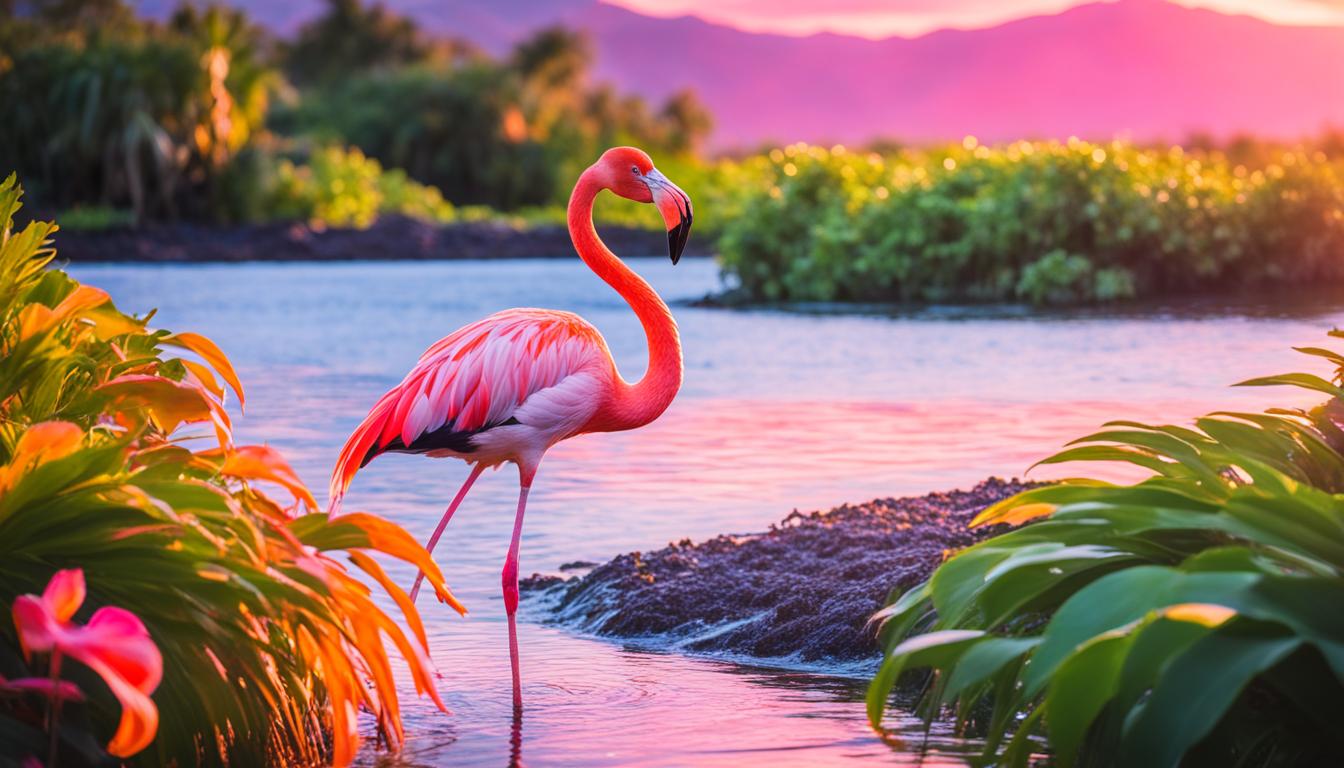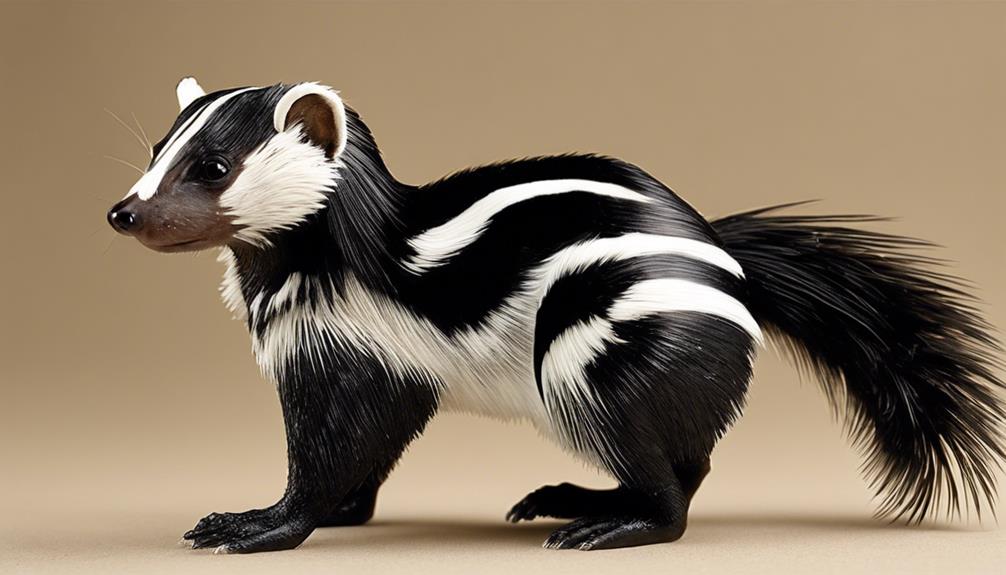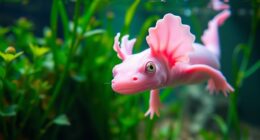Did you realize that nature is the habitat for a range of pink animals, each with their own fascinating stories and vibrant shades? From the dazzling pink feathers of flamingos to the graceful pink bodies of orchid mantises, these animals enchant with their beautiful pink coloration and the remarkable lives they live.
Key Takeaways:
- Pink animals add a touch of charm and fascination to the natural world.
- Flamingos, galah cockatoos, orchid mantises, Amazon river dolphins, pink pigeons, domestic pigs, roseate spoonbills, and more are among the unique pink creatures found in nature.
- Each pink animal species has its own adaptation strategies and ecological significance.
- Conservation efforts play a crucial role in protecting these fascinating creatures.
- Exploring the lives of pink animals allows us to appreciate the wonders and diversity of nature.
Flamingoes – Vibrant Pink Beauties
Flamingoes are iconic pink birds found across parts of South America, Caribbean, Southern Europe, Africa, and Southwest Asia. These majestic creatures are known for their long, slender legs and elegant necks, but what truly sets them apart is their vibrant pink feathers.
Flamingoes’ distinctive pink coloration is a result of their diet. They consume a variety of algae and crustaceans that contain a red-orange pigment called beta-carotene. This pigment gets deposited in their feathers, giving them their characteristic vibrant pink hue.
These social birds are also famous for their mesmerizing synchronized group dances. Large colonies of flamingoes gather together, moving in unison, creating a breathtaking spectacle. These performances not only serve as a display of unity but also play a crucial role in attracting potential mates.
“Witnessing a colony of flamingoes gracefully dancing in unison is a truly awe-inspiring experience. It showcases their extraordinary coordination, communication, and sense of community,” said Dr. Rebecca Evans, an ornithologist specializing in avian behavior.
Flamingoes have great ecological significance as well. They are vital in regulating nutrient cycles in the water bodies they inhabit. As they feed, they filter water through their unique bills, extracting microscopic organisms and stirring up sediments. This process helps in recycling nutrients and maintaining the balance of their ecosystems.
Galah Cockatoo – Playful Pink Parrot
The Galah Cockatoo, also known as the Rose-Breasted Cockatoo, is a highly social and intelligent bird native to Australia. It stands out with its striking pink chest and face, contrasting against its grey back and wings. Galahs primarily feed on seeds, nuts, berries, and roots, and are known for their impressive aerial acrobatics. These birds form strong, lifelong bonds with their mates and nest in tree cavities.
If you ever happen to come across a Galah Cockatoo in the wild, you’ll be captivated by its playful nature and beautiful pink plumage. With their sociability and intelligence, Galahs have become popular pets for bird enthusiasts around the world. Their striking appearance and charming personality make them a delight to observe and interact with.
Distinctive Features
The Galah Cockatoo’s defining feature is its vibrant, rosy-pink chest. This pink coloration, often referred to as “galah grey,” is unique among parrots and gives these birds their distinctive charm. The pink chest contrasts elegantly against the soft grey color of their back and wings, creating a visually appealing combination.
Another fascinating feature of Galah Cockatoos is their crests. When excited or alarmed, their crests can rise and stand upright, adding a touch of whimsy to their appearance.
“The Galah Cockatoo’s pink chest is a striking adaptation that not only enhances their aesthetic appeal but also plays a role in attracting mates, signaling adulthood, and establishing their place within the social hierarchy.”
Behavior and Interaction
Galah Cockatoos are highly social birds, often forming large flocks in the wild. They communicate through a variety of vocalizations, including shrieks, whistles, and mimicry. These parrots are known for their impressive imitating abilities, as they can mimic human speech and various sounds in their environment.
When it comes to bonding, Galahs are incredibly loyal creatures. They form strong pair bonds and spend a significant amount of time engaging in social activities with their mates, such as preening each other’s feathers and engaging in playful behaviors. These lifelong partnerships contribute to the overall well-being and emotional stability of these birds.
Furthermore, Galah Cockatoos are highly intelligent and require mental stimulation to thrive. Toys, puzzles, and interactive activities are essential to keep them engaged and prevent boredom.
Galah Cockatoo Facts
- Galah Cockatoos belong to the Cacatuidae family, which includes various species of white, black, and pink cockatoos.
- Their scientific name is Eolophus roseicapilla.
- These birds are native to Australia and can be found in various habitats, including open woodlands, scrublands, and urban areas.
- Galahs are excellent fliers and can reach speeds of up to 40 miles per hour.
Galah Cockatoo Image

| Galah Cockatoo | |
|---|---|
| Scientific Name | Eolophus roseicapilla |
| Native to | Australia |
| Primary Diet | Seeds, nuts, berries, and roots |
| Coloration | Pink chest, grey back and wings |
| Characteristic Features | Vibrant pink chest, playful nature |
Orchid Mantis – Master of Camouflage
The Orchid Mantis, found in the rainforests of Southeast Asia, is a fascinating insect known for its petal-like limbs and bright pink or white body. Its unique coloration and body shape allow it to blend seamlessly among orchids and other tropical flowers, serving the purposes of hiding from predators and hunting prey.
Despite their delicate appearance, these mantises are skilled predators, capturing prey with their spiny front legs. They patiently wait on flowers, perfectly camouflaged, until an unsuspecting insect approaches. Then, with lightning-fast reflexes, they strike, using their specialized forelegs to grasp and immobilize their prey.
An Ingenious Adaptation
The Orchid Mantis’s pink body serves as an exceptional camouflage strategy. By mimicking the vibrant colors of flowers, they become virtually invisible to both their victims and potential predators. This incredible adaptation enables the mantis to ambush unsuspecting insects, enhancing their chances of survival and successful hunting.
“The Orchid Mantis’s ability to blend seamlessly among flowers is a remarkable example of nature’s ingenuity. Its pink body is a testament to its evolutionary success, allowing it to thrive in its rainforest habitat.”
The Orchid Mantis in Action
When it comes to hunting, the Orchid Mantis showcases impressive precision and cunning. Equipped with sharp spikes on their front legs, they swiftly snatch their prey, immobilizing them with a firm grip before devouring them. Their stealthy hunting style, combined with their ability to disappear among the vibrant blooms, makes them true masters of the rainforest.
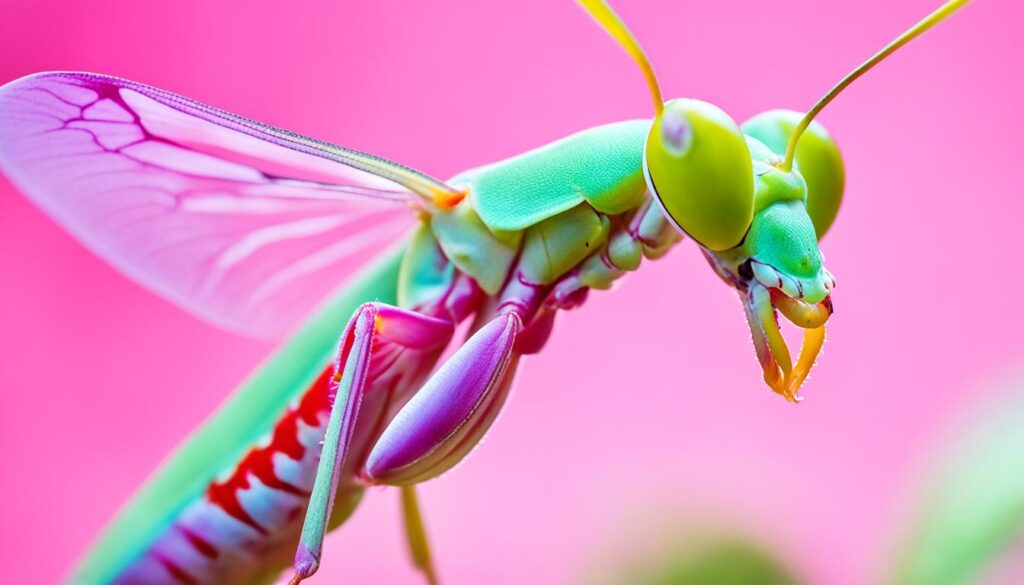
The Orchid Mantis: A Natural Wonder
The Orchid Mantis’s mesmerizing pink body and remarkable camouflage abilities make it a captivating creature of the rainforest. Its unique appearance and hunting strategies demonstrate the incredible diversity and adaptability found in the insect world. The next time you’re exploring the lush rainforests of Southeast Asia, keep an eye out for this delicate yet skilled predator.
| Key Features | Information |
|---|---|
| Scientific Name | Hymenopus coronatus |
| Habitat | Rainforests of Southeast Asia |
| Physical Characteristics | Petal-like limbs, bright pink or white body |
| Feeding Behavior | Skilled predator, captures prey with spiny front legs |
| Camouflage Strategy | Blends among orchids and tropical flowers |
Amazon River Dolphin – Enchanting Pink Marine Mammal
The Amazon River Dolphin, also known as the Pink River Dolphin or Boto, is a captivating freshwater mammal found in northern South America. It is renowned for its distinctive pink color, which intensifies with age or excitement. These gentle creatures have unique adaptations that allow them to thrive in the riverine environment.
The Amazon River Dolphin possesses unfused neck vertebrae, giving them exceptional maneuverability in the water. This allows them to navigate through the dense vegetation and narrow channels of the Amazon rainforest. Their long, slender bodies enable agile movements, making them well-suited for their habitat.

These enchanting dolphins play an essential role in maintaining the balance of their ecosystem. They have a diverse diet that includes fish, crustaceans, and even turtles. By regulating the populations of these prey species, they help promote the overall health and stability of the Amazon River system.
Unfortunately, the Amazon River Dolphin faces numerous challenges and threats. Habitat degradation, caused by deforestation, pollution, and dam construction, greatly impacts their population. Additionally, accidental capture in fishing nets poses a significant risk to their survival.
Conservation efforts are crucial to protecting these fascinating creatures and their delicate ecosystem. By raising awareness and implementing sustainable fishing practices, we can ensure the continued existence of the Amazon River Dolphin and preserve the beauty and richness of the Amazon rainforest.
Pink Pigeon – Forest Dweller of Mauritius
The Pink Pigeon, native to Mauritius, is a bird with a charming pinkish hue on its tail, wings, and beak. It is one of the world’s rare pigeon species adapted to forest life. These pigeons primarily feed on leaves, fruits, flowers, and buds, aiding in seed dispersal and the growth of their forest habitats. Once critically endangered, conservation efforts have helped their population recover, but they are still threatened by habitat loss and introduced species.
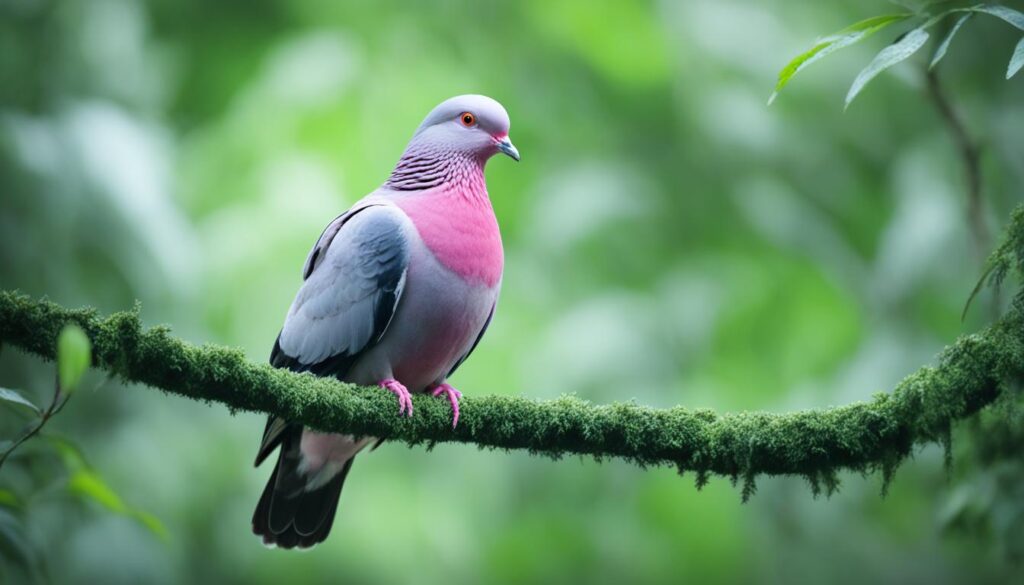
| Species | Scientific Name | Status |
|---|---|---|
| Pink Pigeon | Nesoenas mayeri | Critically endangered |
Domestic Pig – Intelligent and Pink-skinned
The Domestic Pig, descended from wild boars, is a highly social and intelligent mammal often associated with distinctive pink skin. These pigs communicate through various means and have an exceptional sense of smell. Despite their common occurrence in agriculture, they face welfare issues and raise important questions about animal welfare and our relationship with the animals we share our lives with.
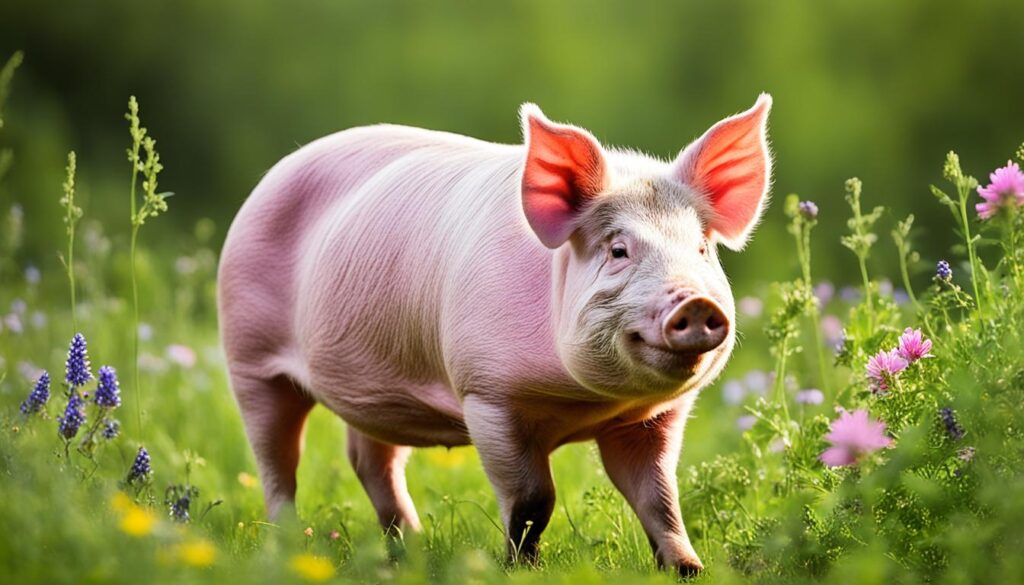
Different pig breeds showcase a range of shades of pink skin, from light peach to deep pink. Their unique coloring adds to their charm and distinguishes them from other mammals. These intelligent creatures have the capacity to form close bonds with each other and display emotional responses to their surroundings.
“Pigs are highly social animals, displaying complex behaviors and strong bonds with their herd members. They communicate through various vocalizations, body language, and even scent marking.”
Their innate curiosity and problem-solving skills make them highly adaptable to different environments. Pigs have been used in animal-assisted therapy programs, where their intelligence and sensitivity have been beneficial in assisting individuals with physical or emotional challenges.
Domestic Pig Characteristics:
- Highly social and intelligent mammal
- Distinctive pink skin, varying in shades
- Exceptional sense of smell
- Communicate through vocalizations and body language
- Curious and adaptable to different environments
Due to their intelligence and social nature, domestic pigs require enrichment activities to stimulate their minds and provide a fulfilling life. Providing them with a suitable environment and proper care is essential for their well-being.
Ultimately, the domestic pig’s pink skin serves as a unique reminder of the fascinating diversity found in the natural world and the intricacies of animal life.
Roseate Spoonbill – Vibrant Wetland Bird
The Roseate Spoonbill is a captivating bird known for its vibrant pink plumage. Found from the southern United States to South America, this beautiful bird stands out with its striking colors.
The pink plumage of the Roseate Spoonbill ranges from light rose to bright magenta, creating a stunning spectacle in wetland environments. As the bird matures, its plumage intensifies, adding to its charm and allure.
One of the most distinctive features of the Roseate Spoonbill is its spoon-shaped bill. This specialized adaptation allows the bird to forage in shallow waters, using its bill to sift through mud and sediment in search of small fish and invertebrates.
Roseate Spoonbills are social birds that often nest in colonies with other wading birds. These colonies not only provide safety in numbers but also serve as indicators of the health of wetland environments. By monitoring the populations and behavior of Roseate Spoonbills, researchers can gain valuable insights into the overall well-being of these crucial habitats.
“The Roseate Spoonbill is a true marvel of nature. Its vibrant pink plumage and unique feeding behavior make it a captivating sight in wetlands.”
Whether feeding, nesting, or soaring through the sky, the Roseate Spoonbill is a symbol of the beauty and diversity of birdlife. Its presence in wetland habitats reminds us of the importance of preserving and protecting these delicate ecosystems.

Fun Facts about Roseate Spoonbills:
- Roseate Spoonbills have a wingspan of approximately 4-5 feet, allowing them to glide gracefully through the air.
- These birds have a lifespan of up to 15 years in the wild.
- During breeding season, Roseate Spoonbills display courtship rituals that involve elaborate dances and displays of affection.
- The vibrant pink color of their feathers is the result of their diet, which includes small crustaceans and insects rich in pigments called carotenoids.
- Roseate Spoonbills are excellent swimmers and can wade through water with ease, using their long legs to navigate through marshy areas.
The next section will explore another fascinating pink animal, the Pink Pigeon.
Conclusion
Pink animals are nature’s charming wonders, captivating us with their vibrant hues and unique characteristics. From flamingoes gracefully wading through the water, to the camouflage mastery of the orchid mantis, these creatures showcase their adaptability and survival strategies in the wild. Exploring the lives of pink animals allows us to marvel at the diversity and resilience of the natural world.
These captivating creatures, such as the Galah cockatoo with its playful nature and the enchanting Amazon River Dolphin, contribute to the delicate balance of their respective ecosystems. Through their role in nutrient cycles and seed dispersal, pink animals play an integral part in the vitality of their environments.
Whether it’s the vibrant wetland bird, the Roseate Spoonbill, or the intelligent and pink-skinned domestic pig, each pink animal offers a unique glimpse into the wonders of nature. Their pink hues not only make them visually striking, but also serve as a testament to their ability to adapt and thrive in their habitats, reminding us of the incredible diversity and resilience found in the world around us.
